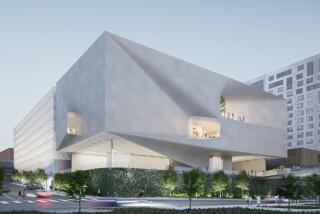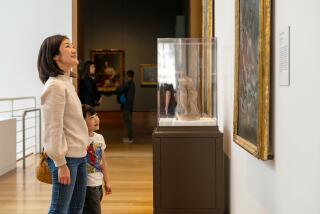Pisano to step down after 13 years leading L.A.’s Natural History Museum
Jane Pisano will step down as president of the Natural History Museum of Los Angeles County after 13 years in which she led the museum to financial recovery in the early 2000s, then oversaw a nearly complete overhaul and updating of the galleries and exhibits at its building in Exposition Park.
Attendance at the two major museums the Natural History Museum runs -- the other is the Page Museum at the La Brea Tar Pits, which displays remains of fossilized mammals and birds recovered from the ooze -- grew nearly 70% over Pisano’s 2001-14 tenure. Together, the two sites drew 1.1 million visitors in the fiscal year that ended June 30.
“Everything I hoped we could accomplish when I arrived here, we’ve done,” Pisano said. “I think it’s time for a new generation of leadership. It’s time for someone else to lead the charge.”
The 70-year-old museum president said she will stay on the job for as long as it takes for its board to hire her successor. “I’m not in a rush to go. I’ve loved every minute of this. Well, almost every minute.”
Pisano had been a professor and dean of USC’s School of Public Administration and a high-level administrator at the university before moving across Exposition Boulevard in fall 2001 to lead the Natural History Museum.
“On my watch, we really focused on the visitors and making their experience more pleasing,” she said. “We let the light in.”
Pisano wasn’t merely speaking figuratively. For decades visitors had encountered some of the museum’s most magnetic attractions, its fossils of dinosaurs and prehistoric mammals, in dimly lighted galleries.
The new “Age of Mammals” exhibit that opened in 2010, followed the next year by Dinosaur Hall, are bright and airy two-level displays of a wide array of species, with the primordial bones augmented by digital touch screens that allow vistors to get in-depth information about the creatures confronting them.
Traditional, old-school attractions, dioramas of dead animals that look lifelike thanks to skilled taxidermy, also were refurbished and their display reconfigured on Pisano’s watch.
The transformation in Exposition Park was completed last year as the museum celebrated its 100th anniversary with the opening of a new glassed-in entrance hall sporting a huge fin whale skeleton as a greeter.
The most recent additions also include outdoor nature gardens to anchor educational programs about the flora and fauna of urban L.A., and a bright and airy basement-level nature lab that offers close-up views of living creatures from Southern California’s natural habitat.
In a city infatuated with stardom, the nature lab has accomplished the unlikely feat of turning everyday brown rats -- normally regarded as vermin -- into cuddly and busily industrious stars of a see-through habitat that’s one of the exhibit’s attractions.
“She literally transformed us, in so many important ways,” said Paul Haaga Jr., who chairs the museum’s board. “Balancing the budget, raising more money, bringing in more visitors.”
Haaga said that board leaders knew Pisano would be stepping down after her most recent contract expired in December and she declined to start a new one.
“She certainly knew she was welcome to stay longer,” Haaga said, joking that he’s thought of stretching out the search for Pisano’s successor to keep her in place for a few more years. “We’ve told her how pleased we were. At the same time, she’s entitled to move on when she’s ready to move on.”
The search for a new leader will move ahead quickly, he said, but with no set deadline.
“We need the leadership type of skills that Jane brought,” Haaga said. “That’s someone who has the right combination of humility and ego strength that’s just too rare. Someone confident enough to lead and humble enough to learn, and Jane had those qualities in spades.”
Pisano doesn’t cast herself as a visionary leader, saying her job was to realize a strategy the museum board had adopted just before she began, embodied in a new mission statement saying its purpose is to “inspire wonder, discovery and responsibility for our natural and cultural worlds.”
“I believe in it and saw its power to point a path forward,” she said.
Natural history museums are multifaceted institutions in which exhibitions in the galleries are complemented by serious original field and lab research by staff scientists and historians. In addition to natural specimens from all times and places, the museum’s collections and exhibits include history and culture of the West and Latin America.
Pisano, whose salary and benefits totaled $439,117 in 2012, according to the museum’s most recent public tax return, said one of her most important tasks was getting the institution’s separate divisions working together in ways that would make everything relevant to the public’s experience at the museum.
“When I came, the researchers thought only about research, and educators thought only about education,” she said. “We changed the culture to be collaborative and team-based. There is an expectation that the scientists doing research will interact with the public. Some of them are tremendously engaged. Others come for special events, bring specimens from the labs and talk about their work from time to time. Everybody does something.”
To achieve the goal of giving its visitors a better experience, Pisano first had to stabilize the museum’s teetering finances and establish it as an institution that donors could confidently support. Deficits totaling $18.9 million had piled up in the five years before she arrived. But by her third full year, starting in mid-2004, the museum was running surpluses and moving ahead with plans to remake the galleries in Exposition Park.
The makeover was accomplished largely with borrowed money -- $89.8 million in bonds -- but Pisano and the board raised substantial sums to ensure they can be repaid on schedule. She said the staff remains about the same size as when she arrived, and spending has not risen drastically -- adjusting for inflation, the museum spent $30.5 million in 2012-13, not counting expenses for depreciation on buildings and equipment. That’s an increase of 13% from spending 10 years earlier.
In rating the museum’s bonds for prospective investors last December, analysts for Moody’s Investors Service said that it was in a good position to pay its debts because of “solid market position, healthy cash flow ... and management’s thoughtful budgeting and multi-year planning.”
Pisano said the museum has raised $117 million toward the $135-million goal of its capital campaign, and she would like to reel in the remaining $18 million before she leaves.
Like the two other major cultural venues sponsored by Los Angeles County, the Los Angeles County Museum of Art and the Music Center, the Natural History Museum receives public funding that covers maintenance and security, and some salaries. It’s up to its staff and board to raise funds for exhibits and programs.
Haaga said the next big project will be giving the Page Museum at the tar pits the kind of update achieved in Exposition Park, although the board has yet to formally set that as a goal or begin planning. The next president may get to be a transformer as well.
“I think ’onward and upward’ would be my three-word instruction to the person” who succeeds Pisano, Haaga said. “Jane has us on a very good track.”
Follow https://twitter.com/boehmm of the L.A. Times for arts news and features
More to Read
The biggest entertainment stories
Get our big stories about Hollywood, film, television, music, arts, culture and more right in your inbox as soon as they publish.
You may occasionally receive promotional content from the Los Angeles Times.







